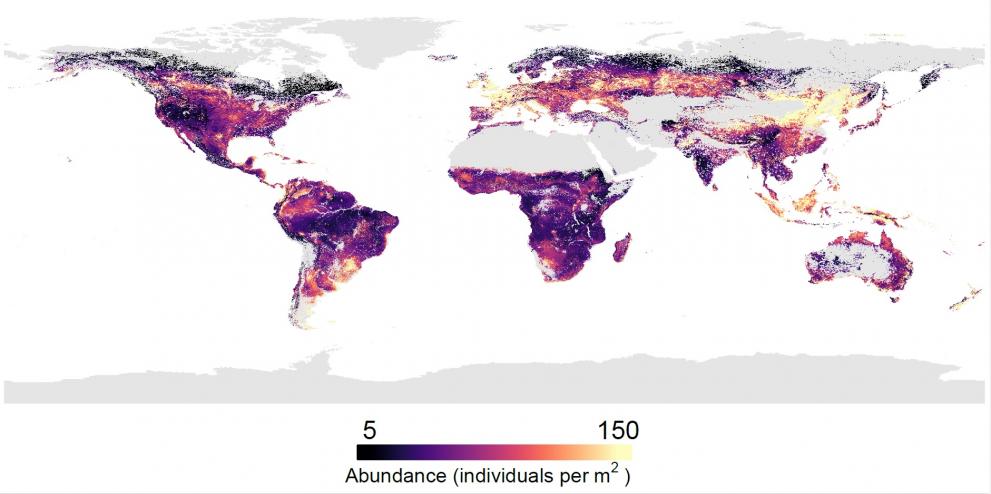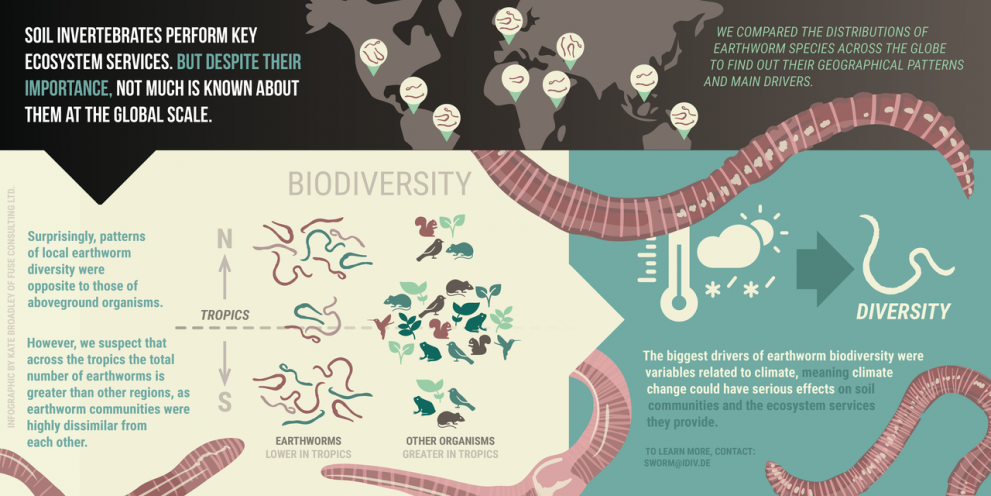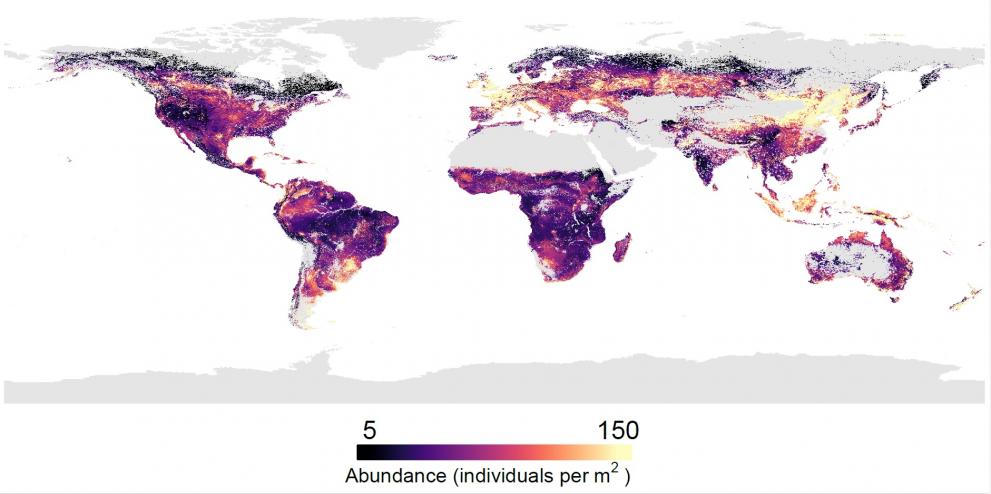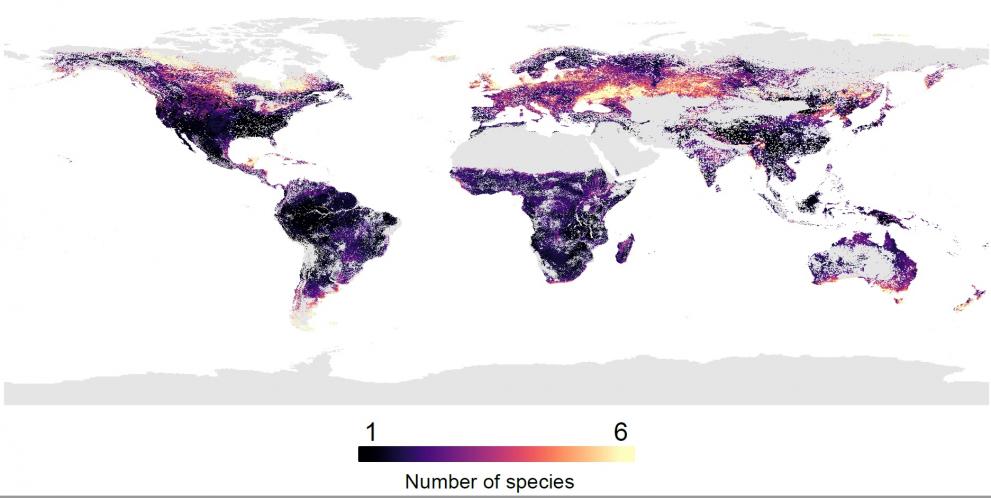
An article published in Science today presents the first global maps of earthworm biodiversity (diversity, abundance and biomass) and shows how these communities and the vital ecosystem services they provide may be seriously affected by climate change, with a cascading effect on other soil species.
The main findings of the research – led by the German Centre for Integrative Biodiversity Research (iDiv) - are that:
- In any single location, there are typically more earthworms and more earthworm species found in temperate regions than in the tropics, and
- Global climate change could lead to significant shifts in earthworm communities worldwide, threatening the many functions they provide.
The authors argue that belowground organisms must therefore be integrated into the biodiversity paradigm if we are to full understand global patterns of biodiversity.

Biodiversity: an above- and belowground issue
In general, current biodiversity conservation measures tend to focus on the variety of plant and animal life found aboveground. This article highlights that belowground biodiversity is also crucial to human survival, and that conservation strategies designed to conserve aboveground biodiversity may not be appropriate for soil biodiversity, especially in a changing climate.
Soils are home to a multitude of living organisms that drive soil biodiversity. According to JRC scientist Alberto Orgiazzi, who was part of the international team of authors of the article, “estimates tell that there are more organisms in the soil than stars in the sky”. However, the full extent of their global biodiversity patterns is still not well understood.
To help understand the wealth of belowground biodiversity and where they occur in the world, the authors compiled the first global maps that predict the earthworm biodiversity, based on their diversity, abundance and biomass.
Why earthworms?
Earthworms are hugely beneficial to terrestrial ecosystems. They are considered to be ‘ecosystem engineers’ that facilitate soil formation (through mixing activity), improve soil quality (through nutrient cycling) and provide a variety of vital ecosystem services and functions for other organisms, including aeration, decomposition and fertilisation.
The ecosystem services provided by earthworms are likely to depend on their abundance, biomass and ecological group. Hence, this map of where they are and in what abundance can help predict how changes in their communities can alter ecosystem functioning.
The study
Using data from 180 earthworm diversity datasets and field studies, the authors created a dataset spanning 57 countries (all continents except Antarctica) and about 7,000 sites, and combined these with environmental drivers to predict local earthworm communities across the globe.
They then modelled the effects of 6 environmental variable themes (soil, precipitation, temperature, water retention, habitat cover and elevation) on species richness, abundance and biomass.
The findings
Highest local species richness (diversity) and abundance were typically found at higher latitudes, while biomass was highest in the tropics. Interestingly, these patterns are the inverse of those observed for aboveground organisms.

Local diversity (species richness) was found to range from 1 to 4 species, with an average of just under 2 per m2 in most parts of the world.
Mid-latitudes, Europe and the north-eastern USA scored particularly high in species richness, in contrast to the diversity patterns of many aboveground organisms. This shows the importance of examining soil and aboveground biodiversity patterns together to fully understand large-scale biodiversity patterns and their drivers, and of using conservation strategies that are safe for both above- and belowground biodiversity.

The typical abundance of local earthworm communities was estimated at 5 to 150 individuals per m2, with a tendency for greater numbers in temperate areas such as Europe, New Zealand and parts of South America than in tropical and sub-tropical regions such as Brazil, Central Africa and parts of China.
Total biomass varied widely, ranging from 1 to 150 g per m2, with areas of high earthworm biomass levels concentrated in the tropics, parts of North America and the Eurasian Steppe. What some tropical areas of Brazil and Indonesia lacked in numbers they made up for in size, with giant earthworm species increasing the biomass rankings for these regions despite their low abundance scores.
Climate the most important driver of earthworm biodiversity
The authors found a strong link between climate and earthworm communities, with precipitation the greatest driver of diversity and biomass, and temperature the greatest driver of abundance.
They found that changes in temperature and precipitation are likely to influence earthworm diversity and distribution, with impacts on the ecosystem functions they provide.
Future research
This study opens an avenue for future research by showing how similar methods to those used to model aboveground biodiversity can be used to model belowground biodiversity, potentially providing a clearer view of the biodiversity distribution of entire ecosystems.
Further information
- Global distribution of earthworm diversity (Science Vol. 366, Issue 6464, 25 Oct 2019)
- Press Release (iDiv): Higher local earthworm diversity in temperate regions than in the tropics
- Above- and belowground biodiversity mismatches
- JRC contributes to the first global assessment of the State of Biodiversity for Food and Agriculture
- The 'earthworm factor' - how biodiversity affects soil erosion
- Global Soil Biodiversity Atlas
- Nature's Dangerous Decline – extinction rates set to accelerate
Related Content
Global distribution of earthworm diversity (Science Vol. 366, Issue 6464, 25 Oct 2019)
Press Release (iDiv): Higher local earthworm diversity in temperate regions than in the tropics
Above- and belowground biodiversity mismatches
JRC contributes to the first global assessment of the State of Biodiversity for Food and Agriculture
The 'earthworm factor' - how biodiversity affects soil erosion
Global Soil Biodiversity Atlas
Nature's Dangerous Decline – extinction rates set to accelerate
Details
- Publication date
- 25 October 2019
